Forest guardians in the Western Ghats
|
Harish R Bhat 1 |
| l |
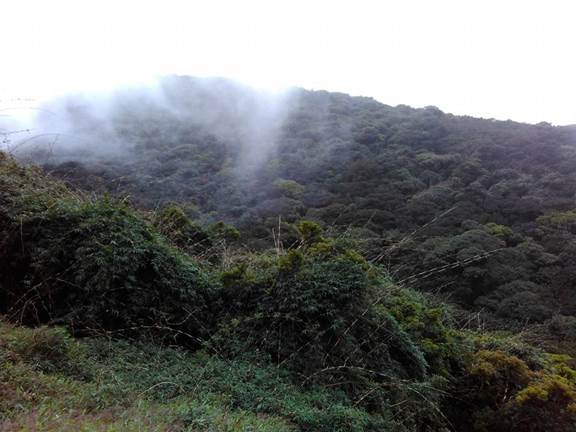
The Western Ghats, constitute a mountain range along the western side of India. The range starts near the border of Gujarat and Maharashtra, south of the Tapti river, and runs approximately 1,600 km through the states of Maharashtra, Goa, Karnataka, Tamil Nadu and Kerala ending at Kanyakumari, at the southern tip of India. The Western Ghats are not true mountains, but are the faulted edge of the Deccan Plateau. They are believed to have been formed during the break-up of the super continent of Gondwana some 150 million years ago. The area is one of the world’s ten "Hottest biodiversity hotspots. Rainfall in this region averages 3,000–4,000 mm with localised extremes touching 9,000 mm. There are about 508 bird species. There are at least 16 species of birds endemic to the western Ghats including the endangered Rufous-breasted Laughing thrush, Nilgiri Wood-pigeon, White-bellied Shortwing and Broad-tailed Grassbird, Grey-breasted Laughingthrush, Black-and-rufous Flycatcher, Nilgiri Flycatcher, and Nilgiri Pipit, Malabar Parakeet, Malabar Grey Hornbill, White-bellied Treepie, Grey-headed Bulbul, Rufous Babbler, Wynaad Laughingthrush, White-bellied Blue-flycatchers and the Crimson-backed Sunbird.
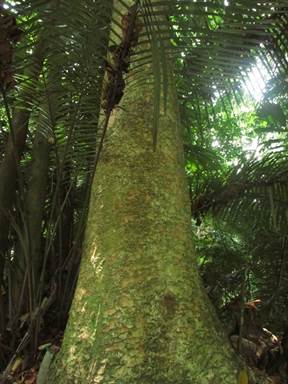
Harish R. Bhat
Birds are specific to vegetation and also the topography, though they fly long distances. They are dependent on micro and macro habitat, food, nesting and roosting places, safety. Hornbills like Malabar Hornbill, Pied Hornbill, Great Indian Hornbill; woodpeckers like Lesser Golden Backed Woodpecker, Great Black Woodpecker, Heart Spotted Woodpecker; Owls like Great Horned Owl, Mottled Wood Owl, Jungle owlet and several tree dependent species nests in tree holes. They prefer old and large trees to chip off the bark and nest. Several birds are quite important for seed dispersal like the Hornbills for dispersing Myristica malabarica, Dillenia pentagyna, Ficus species seeds to distant areas. These seeds when defecated by birds will sprout and grows into trees. Many smaller nectar birds like sunbirds are dependent on nectars of flowers, hence helps in pollination. Several species of woodpecker, barbets help in maintaining healthy woody trees by feeding on the stem boring insects, termites etc. The bird population greatly depends on tall trees that serve them nesting and roosting purposes. They are also interdependent species coexisting with other bird species, thus evident in the species balance. These birds also help in seed dispersal contributing to regeneration of forest cover, thus playing an important role in balancing ecology. They also keep the tree healthy by feeding on the tree borers, termites etc, thus ascribing a high value in maintaining the tree stand value. These birds contribute greatly to the health and growth of the forest. Without these birds there will be a great imbalance in the forest ecosystem, which depletes the rich forest to a larger extent. Their entire life dependent on the trees in the forests, be it for food, shelter and breeding. Birding in western ghats is always a challenge as most of them are found inside the thick foliage of tall trees or bushes. One can hear the bird calls, but will be unable to locate instantly. A constant patience is the need for a birder at western ghats. Many a times there will be several birds together in mixed flock hunting for food, the calls will be quite confusing as all will be active and chirping. There are other mimicking birds like the drongos, which can imitate several sounds heard in the vicinity. Hence, one need to be cautious to confirm the bird call and its presence. Unlike other places, birds in the forests are active most of the day except in the noon. Many are on the canopy of the tall trees, some are on the ground or near the water bodies. Few of the birds with ecological importance are described below for understanding their behavior and life style.
Hornbills:
Generally hornbills are found in wooded region as they are dependent for fruits and nesting on the tall trees. They are locatable due to their loud calls and heavy flapping of wings.
The Great Indian Hornbill (Buceros bicornis); Kannada: Dodda Mangatte:
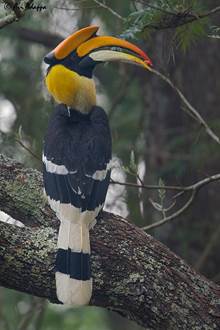
Avinash Adappa
Sighting them is always an excitement as they are quite rare and often on tall trees canopies. It is one of the larger members of the hornbill family. It is found in South and Southeast Asia. It is predominantly frugivorous (feeding on fruits), but is sometimes feed on small mammals, reptiles and birds. The size is 95–130 cm long, with a 152 cm wingspan. Their flight is often compared to ‘aeroplane’ or ‘helicopter’ flight sound. Females are smaller than males and have bluish-white instead of red eyes. Like other hornbills, they have prominent "eyelashes". The most prominent feature of the hornbill is the bright yellow ‘cap-like’ part called ‘casque’ on top of its massive beak. The casque top is concave, with two ridges along the sides that form points in the front. The back of the casque is reddish in females, while the underside of the front and back of the casque is black in males.
During the breeding season from January to April great hornbills become very vocal. They make loud sound. They prefer mature forests for nesting. Large, tall and old trees, seem to be preferred for nesting. They form monogamous pair bonds and live in small groups.
The male scouts and finds an old tree hollow in which female hornbill sits inside. The male seals the opening of the tree hollow with paste made from leaves, decaying wood, soil, feacal matter etc keeping a small opening for the female to protrude her beak outside. She remains there, relying on the male to bring her food, until the chicks are half developed. The male feeds the female and the chicks for some time. During this period the female undergoes a complete moult, losing her feathers. The young chicks have no feathers and appear very plump.. The clutch consists of one or two eggs, which she incubates for 38–40 days. The male helps to break open the seal and the chicks come out. Since the female had shed her feathers to cushion the chicks inside the nest, she will be unable to fly, hence waits till the feathers develop. The male continues feeding the female till she is able to fly. During the incubating duration, if the male is killed, then entire hornbill family dies without food, as they are dependent on the male to feed them.
Malabar pied hornbill (Anthracoceros coronatus); Kannada: Kari Mangatte:
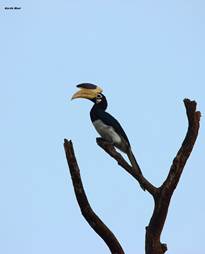
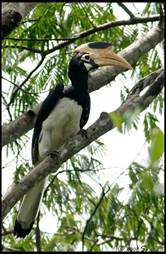
Karthik Bhat Shiva Shankar
It is a common resident breeder in tropical and subtropical Asia. Its habitat is evergreen and moist deciduous forests, often near human settlements. The size of the bird is 65 cm in length. It has mainly black plumage, apart from its white belly, throat patch, tail sides and trailing edge to the wings. The beak is yellow with a large, mainly black casque. Females have white orbital skin, which the males lack. This species is omnivorous feeding on fruits, small mammals, birds, small reptiles, insects etc. Figs are an important food. Breeding season is during March and April.
Malabar grey hornbill (Ocyceros griseus); Kannada: Boodhu Mangatte:
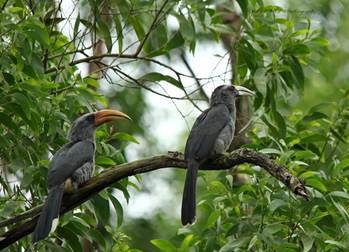
PC:Karthik Bhat
It is endemic to the Western Ghats and associated hills of southern India. They have a large beak but lack the casque that is prominent in some other hornbill species. They are found mainly in dense forest and around rubber, arecanut or coffee plantations. They move around in small groups, feeding on figs and other forest fruits. Their loud ‘baby-like’ crying and shrill laughing call makes them familiar to people living in the region. The bird is medium sized, 45 to 58 cm in length. It has a 23 cm tail and pale or yellowish to orange bill. Males have a reddish beak with a yellow tip, while the females have a plain yellow beak with black at the base of the lower beak. They show a broad whitish ‘eye brow’ band above the eye, running down to the neck. They fly with a strong flap and glide flight and hop around heavily on the outer branches of large fruiting trees. They have brown-grey wings, a white patch and black primary feathers tipped with white. They are found mainly in dense forest habitats; the thinner dry forest habitat of the plains is typically occupied by the Indian grey hornbill.
Woodpeckers:
The woodpeckers are mostly found in wooded region with more number of trees. They generally fly from tree to tree, perch directly on the tree trunk in vertical position, and immediately start chipping the wood for scouting insects and sometimes try to find better place by hopping vertically on the tree. They fly in a wavy fashion with continuous call while in flight. They feed by using their beak to hammer on trees to dig out carpenter ants, termites and wood-boring grubs. The woodpecker will more than likely choose a tree with a fungal disease, such as heart rot, although some will utilize a living, healthy tree. Once a hole has been made, the black woodpecker chips downwards through the trunk of the tree, creating a nesting chamber, the only lining being the woodchips created throughout the process. The woodpecker’s excavations provide homes for many other species of bird and mammal, and are therefore considered to be a "keystone" species in many of its habitats throughout its range. It not only provides habitats for other species, but also controls populations of wood-boring insects, helping to protect the trees. In a way, woodpeckers are ‘doctors’ of the forests, checking the status of the trees periodically!
Black woodpecker (Dryocopus martius); Kannada: Kari Marakutiga:
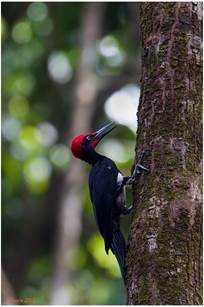
PC:Shiva Shankar
It is a large woodpecker that lives in mature forest. The black woodpecker measures 45 to 55 cm long with a 64 to 84 cm wingspan, the tail is 15.9 to 17.3 cm, the very long beak is 5 to 6.7 cm. The feathers of this crow-sized woodpecker is entirely black apart from a red crown. In males, the entire crown is red, but in females only the top hind crown is red with the rest of the body all black. Their voice is remarkable in that it has two different calls. The black woodpecker is mainly found in forested regions, with a preference for extensive, mature woodland, including coniferous, tropical and subtropical. It is very widespread throughout mountainous and lowland forests. It is more likely to occur in marginal woods near human habitations during the non-breeding season.
Black-rumpedflameback (Dinopiumbenghalense);
Kannada: Arashina Marakuttiga:
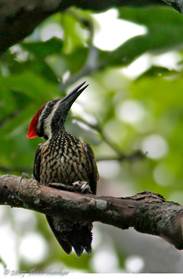
PC:Shiva Shankar
It also known as the lesser golden-backed woodpecker, found widely distributed in the Indian subcontinent. It has a characteristic rattling-whinnying call. It is the only golden-backed woodpecker with a black throat and black rump (back). The black-rumped flameback is a large species at 26–29 cm in length. The rump is black, under parts are white with dark markings. The black throat finely marked with white. The head is whitish with a black nape and throat, and there is a greyish eye patch. The adult male has a red crown and crest. Females have a black crown spotted with white, with red only on the rear crest. Like other woodpeckers, this species has a straight pointed beak, a stiff tail to provide support against tree trunks, and zygodactyl feet, with two toes pointing forward, and two backward. The long tongue can be darted forward to capture insects. They are often seen in urban areas with wooded avenues. They feed on insects mainly beetle larvae from under the bark, visit termite mounds and sometimes feed on nectar. The breeding season varies with weather and is between February and July.
Heart-spotted woodpecker (Hemicircus canente);
Kannada: Chikka Marakuttiga:
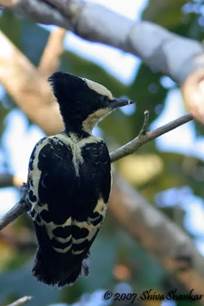
PC:Shiva Shankar
It has a contrasting black and white pattern, a distinctively small body with a large wedge-shaped head making them easy to identify while their frequent calling. They move about in pairs or small groups and are often found in mixed-species foraging flocks. They have a wide distribution across Asia with populations in the forests of southwestern and central India. Both males and females are predominantly black with ‘heart-shaped’ black spots on white shoulders with broad white scapular patches and barring of flight feathers. The female has the forehead and crown buffy white while it is black on males. The throat is whitish and the underparts are dark olive grey. Its natural habitat is subtropical or tropical moist lowland forests.
Trogon:
Trogons are birds found in dense evergreen forests. Most of the times they are silent, sitting still and hardly move. Hence they are not sighted commonly.
Malabar trogon (Harpactes fasciatus); Kannada: Kakarne hakki :
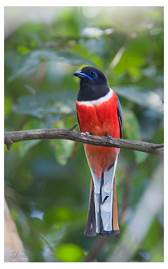
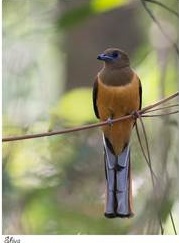
PC:Shiva Shankar PC:Shiva Shankar
They are insectivorous birds feeding mainly on insects. Like in other trogons, males and females vary in plumage. The male has a slaty black head and breast with a white border-appearing like a ‘necklace’ to the black head separating it from the crimson on the underside. The back is dark brown to chestnut colour. The tail-feathers are chestnut with a black tip. The female lacks the contrasting black and crimson and has only a slightly darker head and breast that shades into the olive brown on the back while the crimson of the underside of the male is replaced by ochre. It is found in the forests of Sri Lanka and peninsular India. In India it is mainly found in the Western Ghats, hill forests of central India and in parts of the Eastern Ghats. The breeding season in India is mainly February to May.
Owls:
Owls are mostly solitary and nocturnal (night) birds, possessing a large, broad head, binocular vision, sharp talons, and special feathers adapted for silent flight. Owls hunt mostly small mammals, insects, and other birds although a few species specialize in hunting fish. They are found in all regions of the Earth except Antarctica and some remote islands. They are regarded as controller of the major pest-rodent population, thus maintaining ecological balance. They are often mistaken that they cannot see during day, which is not true. Their vision is blur during day and sharp during night. They patiently wait for preying on food, strategically position themselves, grab instantly and fly to nearby trees or any perching places.
Indian eagle-owl (Bubo bengalensis); Kannada: Kombina Goobe:
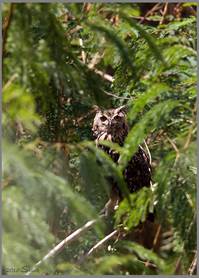
PC:Shiva Shankar
It is also called the rock eagle-owl or Bengal eagle-owl is a species of large horned owl found in the Indian Subcontinent. They are found in hilly and rocky scrub forests, and are usually seen in pairs. They have a deep resonant booming call that may be heard at dawn and dusk. They are typically large owls, and have "tufts" on their heads appearing like ‘horns’. They are splashed with brown and grey, and have a white throat patch with black small stripes. This species is often considered a subspecies of the Eurasian eagle-owl Bubo bubo and is very similar in appearance. They are seen in scrub and light to medium forests but are especially seen near rocky places. Their diet through much of the year consists of rodents. The nesting season is November to April.
Mottled wood owl (Strix ocellata); Kannada: Geeru Goobe:
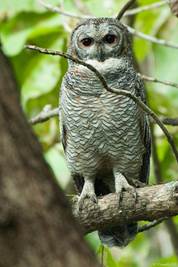
PC:Vineeth Kumar K.
It is a species of large owl found in India. They are found in gardens and thin deciduous forests adjacent to dry thorn forests or farmland. They are easily detected by their distinctive scary calls at dawn and dusk. The characteristic call is a duet of the male and female while other notes include a low hoot and a screech. The concentric barring on the face makes them easy to identify. The species is found in the plains in gardens and lightly wooded habitats. They roost in trees during the day choosing a branch with dense foliage. These owls roost in the day, usually in pairs. When disturbed they may fly in bright sunshine although they choose to shelter within a dense grove of trees. They produce an eerie ‘chuhua’ call that sometimes scare listeners. The calling is more frequent in November when they begin to breed. Most Nests are found from February to April.